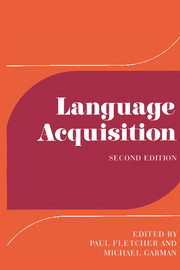Book contents
- Frontmatter
- Contents
- Contributors
- Preface
- Part I Contexts and determinants
- Part II The development of linguistic systems: phonology
- Introduction
- 7 Prespeech segmental feature development
- 8 Prosodic development
- 9 Early strategies for the perception and production of words and sounds
- 10 Phonological development: production
- 11 Speech perception and the emergent lexicon: an ethological approach
- 12 Phonological development: a crosslinguistic perspective
- Part III The development of linguistic systems: grammar
- Part IV Later language development
- Notes to chapters
- Bibliography and citation index
- General index
- Titles in the series
12 - Phonological development: a crosslinguistic perspective
Published online by Cambridge University Press: 05 June 2012
- Frontmatter
- Contents
- Contributors
- Preface
- Part I Contexts and determinants
- Part II The development of linguistic systems: phonology
- Introduction
- 7 Prespeech segmental feature development
- 8 Prosodic development
- 9 Early strategies for the perception and production of words and sounds
- 10 Phonological development: production
- 11 Speech perception and the emergent lexicon: an ethological approach
- 12 Phonological development: a crosslinguistic perspective
- Part III The development of linguistic systems: grammar
- Part IV Later language development
- Notes to chapters
- Bibliography and citation index
- General index
- Titles in the series
Summary
Introduction
A central challenge for a theory of language acquisition is the coexistence of extensive diversity – across time, languages and children – and striking similarities – patterns that seemingly must derive from some set of invariant properties of the language capacity. Not only these general patterns, but also the speed of development and the relative uniformity of the final state seem to require invariant properties behind the child's convergence on what is, in all respects, a highly complex system. In child phonology, as in phonology generally, the last several decades have been dominated by the search for invariance, for universals of acquisition. We are indebted largely to Jakobson (1968) for two fundamental premises of our field: first, that the utterances of the young child constitute ‘language’ in the sense of being rule-governed at all stages (save perhaps babbling); and second, that the governing principles are consistent with those principles that define and constrain phonological systems generally. Yet the universalist character of this period is not without prominent exceptions (see, for example, Olmsted 1971, for acquisition, and proponents of the British prosodic school for general phonology); and it has been suggested that many details of acquisition are random or result from ephemeral details of input or experience (McCawley 1979).
- Type
- Chapter
- Information
- Language AcquisitionStudies in First Language Development, pp. 251 - 268Publisher: Cambridge University PressPrint publication year: 1986
- 1
- Cited by

